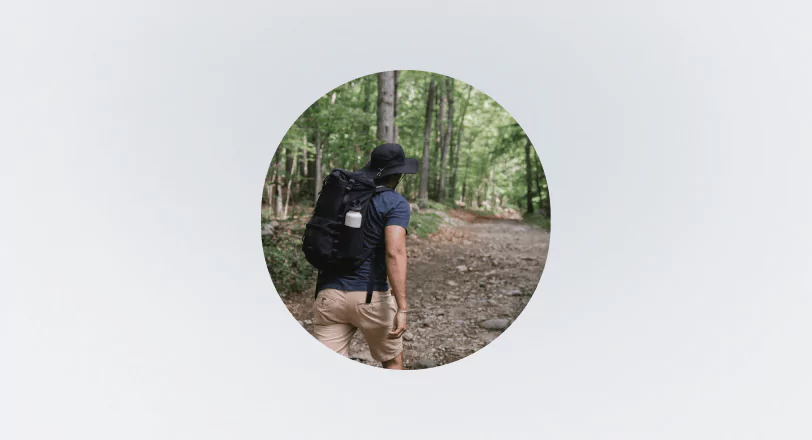Not every customer is the right customer, especially when it comes to adventure travel.
One unfit, unprepared, or unwilling guest can compromise the safety of your group, disrupt your itinerary, and damage your reputation.
Still, many adventure tour operators hesitate to screen their customers. The concern is understandable. No one wants to turn away paying clients and risk losing revenue.
But the reality is that not having a clear screening process can cost much more. It creates liability issues, affects the experience for other guests, and puts long-term brand trust at risk.
As an adventure travel business owner, you already understand how critical it is to manage risk. What you might not have is a consistent and professional method for evaluating customers before they ever join your tour.
In this guide, you will learn how to do exactly that. You will get practical screening steps, must-ask questions, common red flags to watch for, and strategies for saying no without damaging your reputation.
The Risk of the Wrong Customer

In adventure tourism, the stakes are higher than in most industries. For one thing, you are responsible for people's safety in unpredictable environments. Really, the wrong customer can put that entire responsibility at risk.
Safety is Your Top Priority

The hard truth is this: an unprepared or physically incapable guest is just a liability. When someone overstates their fitness level or ignores safety instructions, their actions can compromise the safety of the entire group. In remote or high-risk settings, that kind of behavior can lead to serious accidents and serious consequences.
Ruin the Group Dynamic

Adventure tours often rely on trust, cooperation, and group morale. One bad-fit guest who complains constantly, refuses to participate fully, or slows the group down can frustrate other participants.
It drags down the experience for everyone and leaves the rest of the group wondering why they paid for a group adventure that is anything but.
Damage Your Reputation

Online reviews are powerful. One customer who felt misled or uncomfortable can leave a public review that undercuts your hard-earned credibility. Even if their complaint comes from their own lack of preparation, it still reflects on you.
Reputation damage like that is hard to reverse.
Increase Refund and Insurance Claims

Unfit or mismatched guests are more likely to request refunds, file complaints, or in worse cases, open insurance claims. Without clear screening procedures in place, it becomes harder to defend your decisions or show that your tour was delivered as promised.
Screening is about ensuring that every guest gets the experience they signed up for, safely and enjoyably. When the wrong person is on the trip, everyone pays for it, including you.
How to Create a Pre-Screening System

Having a clear system for screening customers does more than protect your business. It shows professionalism, sets expectations early, and helps build trust with the right guests. The goal is to gather the right information before someone books, so you can evaluate whether they’re a good fit for the tour.
Here’s how to build a pre-screening process that works.
Use an Intake Form Before Confirming Bookings

Start by building a simple form that every guest fills out before their booking is confirmed. This can be part of your website or a separate email follow-up. The form should include key questions about fitness, experience, and any relevant medical conditions.
Ask things like:
- What similar tours or activities have you done before?
- How often do you exercise or engage in outdoor activities?
- Do you have any medical conditions or injuries we should be aware of?
- Are you comfortable with heights, water, confined spaces, etc.?
This helps you gather data early and flag any obvious mismatches before money changes hands.
Add a Short Phone or Video Call For High-Risk Tours

If your tour is physically demanding or has safety-critical elements, schedule a short phone or video call after the form is submitted. This gives you a chance to verify the information, ask follow-up questions, and get a sense of the guest’s attitude and awareness.
It also gives the customer a chance to ask questions. That alone can often reveal whether they’ve paid attention to your tour description or are coming in with the wrong expectations.
Be Clear in Your Tour Description

Your screening process starts with your marketing materials. Make sure your website, brochures, and booking pages clearly state the physical requirements, risks, and skill levels involved.
Use specific language and avoid vague terms like “moderate fitness.” Instead, say something like: “You must be able to hike six miles over uneven terrain, carrying a 10-pound pack, in hot weather.”
When you’re clear upfront, it helps people self-select before they ever reach your form.
Include Waivers and Disclaimers

A waiver is a legal protection and also part of the screening process. When someone reads and signs a well-written waiver, it reinforces the risks and responsibilities involved. If they push back or hesitate, that might be a sign they aren’t ready for the experience.
Make sure your waiver is professionally written and easy to understand. Avoid legal jargon that hides the real meaning.
Train Your Team to Spot Red Flags Early

If you have guides or customer service staff handling bookings, they should be trained to spot potential issues.
That includes vague answers, inconsistent information, overconfidence, or signs that the guest hasn’t read the tour details. Teach your team how to ask clarifying questions and escalate concerns to you when needed.
Must-Ask Screening Questions

The questions you ask during the screening process can make or break your ability to spot a bad fit early. They need to be clear, respectful, and designed to draw out honest, useful answers.
You are not just collecting information. You are reading between the lines for confidence, consistency, and common sense.
Here are the key questions every adventure tour operator should ask before confirming a booking:
1. What Experience Do You Have With This Type of Activity?

Why it matters: This helps you quickly assess whether the guest understands what they are signing up for. A guest who says, “I’ve never done anything like this before, but I’m pretty sure I’ll be fine,” may need a closer look.
What to listen for: Specific examples of relevant experience. Vague or overconfident answers should be flagged.
2. How Physically Active Are You on a Regular Basis?

Why it matters: You need to know if a guest has the endurance and fitness level your tour demands. This is especially important for multi-day trips or high-altitude adventures.
What to listen for: Details that match the physical requirements of your tour. Watch out for guests who are overly ambitious or clearly downplaying limitations.
3. Do You Have Any Medical Conditions or Injuries That Could Affect Your Ability to Participate?

Why it matters: This question helps you protect both the guest and your team. It is also a legal safeguard when used with your waiver and liability form.
What to listen for: Honest disclosures. If someone hesitates or gives a vague answer, follow up. Guests may be reluctant to share, but your job is to ensure their safety
4. Are you Comfortable With [Specific Risk Factor]?

Customize this based on your tour. For example:
- “Are you comfortable with heights?”
- “Are you able to swim in open water?”
- “Are you okay with being in remote locations without cell service?”
Why it matters: It filters out people who might panic or freeze during key moments, putting themselves or others in danger.
What to listen for: A clear yes or a thoughtful answer. If someone hesitates, ask why and dig a little deeper.
5. Have You Read the Full Tour Description, Including Physical Requirements and Risks?

Why it matters: It checks if they’ve actually paid attention. Many guests skim or ignore details, which leads to unmet expectations and unnecessary complaints.
What to listen for: A confident yes, followed by questions or comments that show they understood. If they say yes but can’t repeat key details, that’s a red flag.
6. Do You Have Any Concerns or Questions About the Tour?

Why it matters: This opens the door for honest conversation. Guests who ask thoughtful questions are more likely to be prepared and take the experience seriously.
What to listen for: Real engagement. If someone says “nope, all good” without showing any curiosity, they may not be fully aware of what they’re booking.
These questions help you evaluate someone’s mindset, level of preparation, and expectations. That gives you the information you need to decide if they are a good fit for your tour, and if not, how to move forward with confidence.
Turning Screening Into a Selling Point

Screening can protect your business and become a key part of your brand message, something that sets you apart from competitors and builds trust with the right customers.
When done well, your screening process shows that you’re experienced, professional, and committed to delivering a high-quality adventure.
Here’s how to turn screening into a positive part of your customer experience.
Explain Your Process Upfront

Don’t hide your screening steps. Let potential guests know that you use a quick intake process to make sure every tour is safe and enjoyable. This creates transparency and helps set expectations early.
Example: “We ask a few short questions before confirming bookings to make sure every guest is matched with the right experience. It helps us deliver the best trip possible.”
Frame it as a Value-Add, Not a Barrier

Instead of positioning screening as a gate they have to pass through, present it as something that benefits them. It shows that you care about providing a safe, enjoyable experience for everyone involved.
Messaging to consider:
- “We tailor our tours to fit each group.”
- “Your safety and satisfaction are our priority.”
- “We make sure every guest is set up for success.”
Build it Into Your Brand Language

Use your marketing to reflect your standards. If your tours are designed for a specific skill level or type of traveler, say so proudly. The right people will feel more confident booking with you.
Examples:
- “Adventure travel for serious hikers.”
- “Guided tours built for outdoor enthusiasts, not first-timers.”
- “Safety-first, skill-matched experiences.”
Use Reviews to Back it Up

Encourage happy customers to mention your attention to detail and preparation in their reviews. These kinds of testimonials reinforce that your screening process leads to better trips.
Example from a review: “I appreciated the pre-trip questions. It showed they really care about making sure everyone’s prepared.”
Make it Part of Your Customer Journey

From the first inquiry to post-tour follow-up, your screening process should feel like part of the experience. Use friendly language, offer support during the process, and make it easy for guests to engage with.
When done right, screening does more than filter out the wrong guests. It gives the right ones more confidence in you. It strengthens your brand, improves your tours, and leads to better word of mouth. And in a crowded market, that’s one of the most valuable things you can offer.
Conclusion
As an adventure tour operator, you already know how much planning, risk management, and responsibility goes into every trip. But the people you bring along can either support that effort or undo it entirely.
Having a professional screening process is about creating the conditions for a safe, successful, and memorable experience for your guests, your guides, and your business.
With the right questions, clear communication, and a confident approach, you can identify the guests who are a great fit and politely turn away those who aren’t. And in doing so, you protect what matters most: the quality of your tours and the reputation of your brand.





